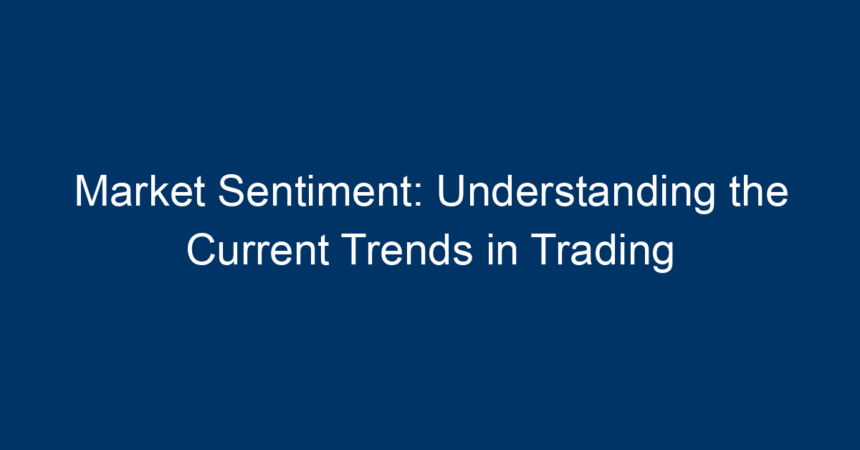In the dynamic landscape of financial markets, traders often find themselves navigating a labyrinth of data, indicators, and emotional cues. At the heart of these decisions lies a powerful concept: market sentiment. Understanding market sentiment is crucial for investors looking to make informed decisions that align with current trends. This article will delve deep into market sentiment, exploring its significance, factors that influence it, and how traders can harness this knowledge effectively.
What is Market Sentiment?
Market sentiment refers to the overall attitude of investors toward a particular security or financial market. It is the collective feeling or mood regarding market conditions and can greatly impact trading behavior. Positive market sentiment usually drives prices upwards, while negative sentiment tends to push prices down. While market sentiment can sometimes be driven by rational analysis, it is often influenced by psychological factors and emotions.
The Importance of Market Sentiment in Trading
Understanding market sentiment is essential for several reasons:
-
Predictive Power: Market sentiment can provide valuable insights into future price movements. By gauging how investors feel about a security, traders can anticipate potential market shifts.
-
Risk Management: Knowing the prevailing sentiment helps traders position themselves appropriately based on market conditions. For instance, a highly negative sentiment might indicate an opportunity to short a stock, while positive sentiment could signal a buying opportunity.
- Emotional Insight: Trading is as much about psychology as it is about finance. By understanding market sentiment, traders can better navigate emotional pitfalls that often lead to poor decision-making.
Factors Influencing Market Sentiment
Several factors contribute to fluctuations in market sentiment:
Economic Indicators
Economic indicators such as GDP growth, unemployment rates, and inflation figures significantly influence market sentiment. Positive economic data typically fosters a bullish sentiment, while negative reports may create bearish feelings among investors.
News and Events
Breaking news—such as political events, natural disasters, or corporate scandals—can quickly alter market sentiment. For example, a sudden diplomatic agreement might boost investor confidence, while unexpected regulatory changes could spark fear and uncertainty.
Social Media and Online Communities
In today’s digital age, social media platforms and online trading communities have become powerful influencers of market sentiment. Viral posts, tweets, or online discussions can sway investor opinions almost instantaneously.
Market Trends and Technical Analysis
Technical indicators such as moving averages or RSI (Relative Strength Index) can also help gauge market sentiment. Bullish trends usually elicit a positive sentiment, while bearish trends foster negativity. Traders often combine technical analysis with sentiment analysis for a well-rounded view.
Tools and Techniques for Analyzing Market Sentiment
Understanding market sentiment is not just about intuition; there are several tools and techniques traders can utilize:
Sentiment Indicators
Tools like the Consumer Confidence Index (CCI) and the Sentiment Survey measure how optimistic or pessimistic consumers feel about the economy. These indicators can provide valuable insights into market sentiment trends.
Social Media Analytics
Using tools that aggregate and analyze social media sentiment can reveal how investors feel about specific stocks or the market as a whole. Tracking hashtag trends or sentiment scores can aid in identifying shifts in investor mood.
Market Surveys
Regular surveys, like those conducted by Bloomberg or Gallup, gauge professional investor sentiment. These insights can provide valuable context for market movements and potential future trends.
Volatility Index (VIX)
The VIX, often referred to as the "fear index," measures market volatility and can be a barometer for market sentiment. High levels of fear typically indicate negative sentiment, while lower levels suggest confidence among investors.
How to Utilize Market Sentiment in Trading Decisions
Strategy Development
Incorporating market sentiment into a trading strategy allows one to align trades with prevailing market moods. For example, a trader might decide to go long when sentiment is bullish and short when sentiment turns bearish.
Timing Your Trades
Understanding market sentiment can help traders decide the optimal entry and exit points for trades. Buying during bullish sentiment and selling during bearish sentiment can maximize profit potential.
Diversification of Portfolio
By understanding sentiment, traders can diversify their portfolios more strategically. For instance, if the sentiment is negative in one sector, investing in assets that are less correlated may mitigate risk.
Avoiding Emotional Trading
Being aware of market sentiment helps traders remain calm and make rational decisions, rather than succumbing to emotional impulses. Keeping a sentiment journal can aid in tracking feelings and decisions over time.
Challenges in Analyzing Market Sentiment
While understanding market sentiment is vital, it’s not without challenges:
Noise in the Data
Market sentiment can be noisy and often influenced by fleeting events or market rumors. Traders need to filter out the irrelevant noise to get an accurate understanding of the sentiment.
Overreacting to Headlines
A common pitfall is overreacting to news headlines. Traders must differentiate between temporary sentiment changes and underlying trends to avoid poor trading decisions.
Sentiment Lag
Market sentiment may lag behind actual market moves. As a result, traders need to be wary of acting too late based on sentiment alone.
Conclusion: Actionable Insights for Traders
Understanding market sentiment is an essential skill for any trader. Here are some actionable insights to enhance trading strategies based on sentiment analysis:
-
Stay Informed: Regularly consume financial news, reports, and sentiment indicators to keep abreast of market conditions.
-
Utilize Technical Analysis: Combine sentiment analysis with technical indicators to develop a comprehensive understanding of market trends.
-
Diversify Investments: Be mindful of broad market sentiment and diversify your portfolio to hedge against negative trends.
-
Keep a Sentiment Journal: Document your trading decisions and the sentiment context at the time to improve your understanding of emotional influences on your trading behavior.
- Educate Yourself and Adapt: The financial markets consistently evolve. Invest time in learning about new tools and methodologies to analyze market sentiment effectively.
Incorporating a rigorous study of market sentiment into trading strategies can unlock new opportunities, refine decision-making processes, and yield long-term success in financial markets. Remember, knowledge is power, and in the world of trading, understanding market sentiment is the key to unlocking that power.




